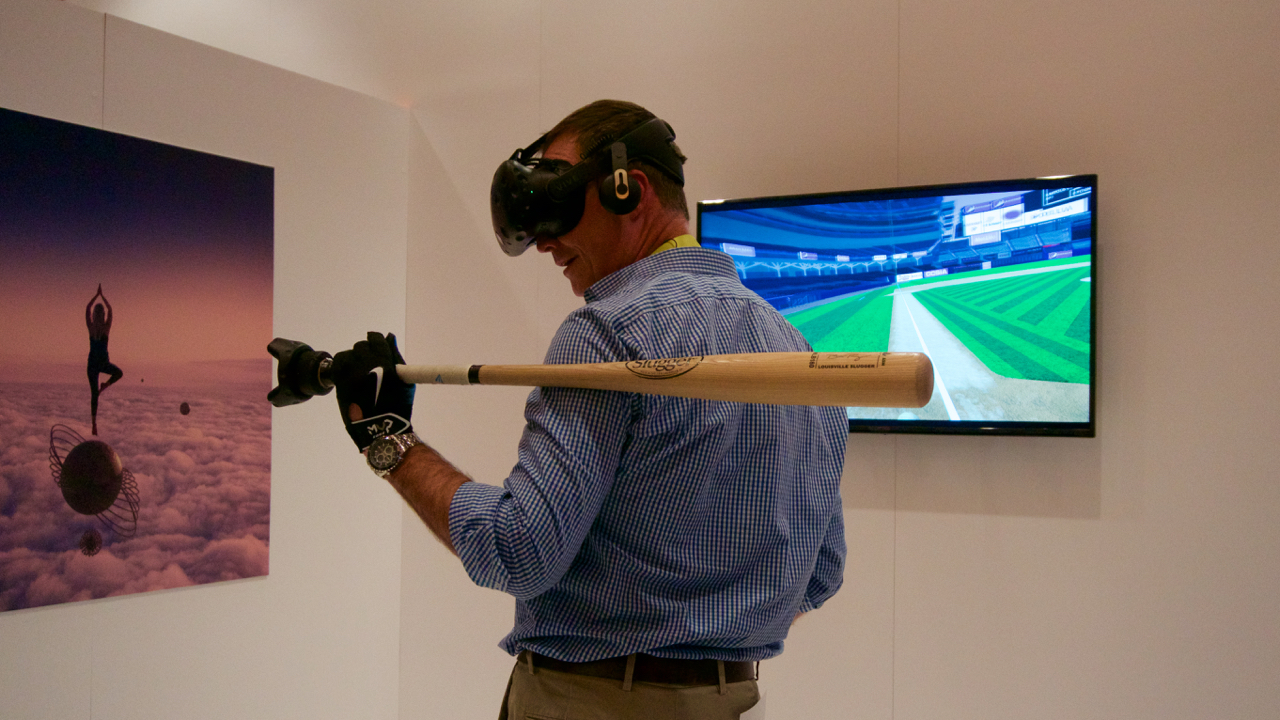Swinging a real bat at MLB pitches is the most intimidating thing I've done in VR
Turns out the weight of a real baseball bat is pretty scary when you can't actually see your hands.

A VR game has finally scared me, but I wasn't creeping through a haunted house or shooting at hordes of zombies. I was holding a real baseball bat, facing down 70 mile per hour pitches, almost too paralyzed to swing it. That might've had something to do with the $2000 of PC gear running TrinityVR's DiamondFX baseball simulation a few feet away from the hunk of wood I was holding in my hands—a hunk of wood I couldn't actually see, with the HTC Vive strapped to my head. Also, it turns out real pitches are a hell of a lot more intimidating than the walking dead.
DiamondFX isn't currently a game—it's a VR simulation of real Major League Baseball pitches, using data collected from pro pitchers over the past decade or so. Unlike generously arcadey batting simulations I've played in the past, like the dinky Wii Sports and the dinkier VR Baseball, pitches in DiamondFX come at you with the speed of the real thing. And because they emulate real pitches, they'll twist away at the last second to catch a corner of the strike zone, or come straight down the middle so fast you can't react the way you can in most games. For an MLB player or a Street Fighter pro, the insanely narrow window of about 150 milliseconds is somehow enough time to act. When I played DiamondFX at GDC, no one had gotten a hit off a real pitch.
I didn't fare any better, but I spent most of my time marveling at how surreal it felt to be swinging a heavy baseball bat that I couldn't see (and hoping for four balls in a row so I didn't strike out like a complete chump). It's a completely different experience than swinging a controller, and I love that HTC's new Vive Tracker peripheral, mounted at the base of the bat, is accurate enough to determine how and where I'm swinging. I think I'd prefer it if it was mounted to something that felt a bit less destructive in my unsure grip.
I did have the guts to swing at some more reasonable pitches, at least. Before turning on the real pitching data and upping the speed to 70+ mph, TrinityVR started me off with some slower, less tricky pitches I could actually get a piece of. I hit a few foul balls and ground outs that almost felt like victory.
My favorite thing about the demo, though, was rewatching the pitches in slow motion as they traveled through a three dimensional representation of the strike zone. I doubt I've watched a baseball game in my adult life without saying "Bullshit, that wasn't a strike" at least once. Watching a replay of my swing made me eat those words.
Trinity suggests that because it uses real data, DiamondFX could be used as a scouting tool to find promising players. Players who can actually hit those fastballs, and aren't scared about accidentally smashing a PC with an errant swing. I'm sure talented batters could make me look like a second-string little league player by comparison, but I'm skeptical that batting in VR is yet representative of batting in real life. The speed's there. The bat's there. But I've never felt more held back by a VR screen than I did in DiamondFX, squinting at a pixel array to spot the tiny white ball leave the pitcher's hand.
I'm not sure there's enough detail there for a genuine simulation. If eyesight and instincts are crucial in the tiny window batters have to swing at a ball, could VR genuinely replicate the same experience? As a teaching tool, it's great—the replay feature let me study my swings and realize I was often hitting the slower pitches too early, smacking them into the ground. I have no doubt I could become a better batter by studying those replays (and swinging more confidently without an expensive demo station setup just out of batting reach). But we might need 8K plastered to our faces before the fidelity is there to properly spot and react to a pitch.
Keep up to date with the most important stories and the best deals, as picked by the PC Gamer team.
TrinityVR told me it plans to create a more consumer-friendly version of DiamondFX down the line, but the software is currently aimed at real MLB teams and professionals. The Vive tracker will be available this year for $100, and I suspect a baseball bat is one of the least outlandish things we'll see it stuck on by the end of the year.

Wes has been covering games and hardware for more than 10 years, first at tech sites like The Wirecutter and Tested before joining the PC Gamer team in 2014. Wes plays a little bit of everything, but he'll always jump at the chance to cover emulation and Japanese games.
When he's not obsessively optimizing and re-optimizing a tangle of conveyor belts in Satisfactory (it's really becoming a problem), he's probably playing a 20-year-old Final Fantasy or some opaque ASCII roguelike. With a focus on writing and editing features, he seeks out personal stories and in-depth histories from the corners of PC gaming and its niche communities. 50% pizza by volume (deep dish, to be specific).

